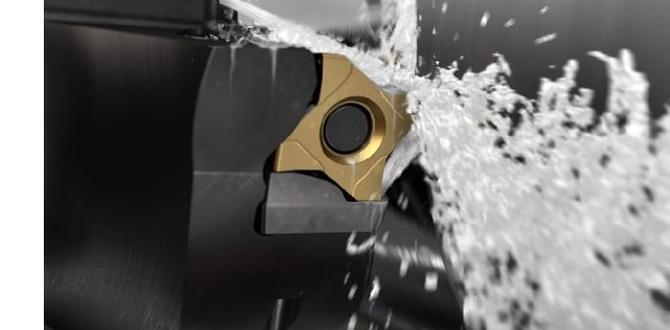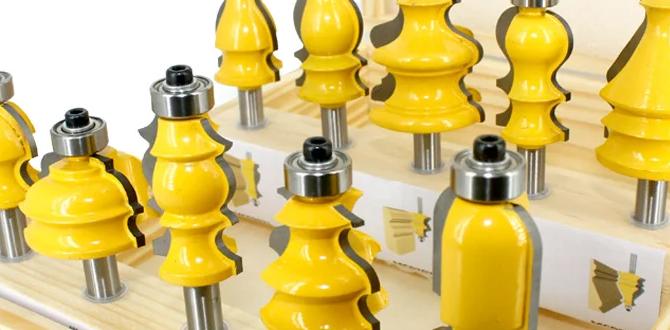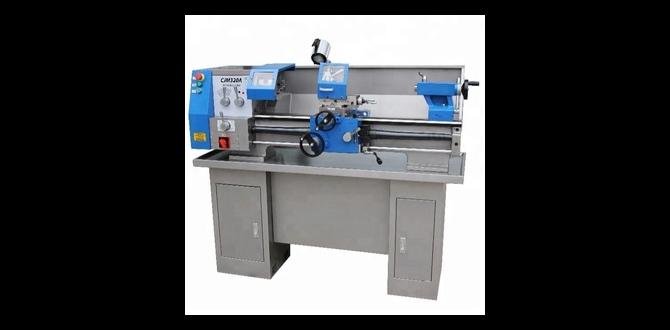A 1/8 inch carbide end mill is crucial for machining PEEK plastics, offering precision and durability for tight-tolerance parts. Its small diameter and carbide material make it ideal for the challenges PEEK presents, ensuring clean cuts and accurate results.
Machining PEEK (Polyetheretherketone) can feel like a puzzle, especially when you’re aiming for those super-precise parts. One common hiccup? Getting clean, accurate cuts without melting or deforming the plastic. This is where the right tools make all the difference. If you’ve been wrestling with PEEK, you might have already discovered that standard bits just don’t cut it. Don’t worry, it’s a solvable problem! The secret weapon for many in your situation is a specific type of cutting tool: the 1/8 inch carbide end mill. This little powerhouse is often the key to unlocking smooth, precise PEEK machining. We’ll walk through exactly why it’s so essential and how to use it effectively.
The Magic of the 1/8 Inch Carbide End Mill for PEEK
PEEK is a fantastic engineering thermoplastic. It’s strong, heat-resistant, and has excellent chemical properties. But these same qualities make it tricky to machine. It’s tough and can melt if you get too much friction. This is where the 1/8 inch carbide end mill steps in. It’s not just any end mill; its specific characteristics make it perfect for tackling PEEK’s unique challenges.
Why this Specific Size and Material?
Let’s break down what makes a 1/8 inch carbide end mill such a standout choice for PEEK machining:
- Material Hardness: Carbide is much harder than steel. This means it stays sharp longer, resists wear better, and can handle the toughness of PEEK without dulling quickly.
- Heat Resistance: Machining plastic, especially PEEK, can generate heat. Carbide can withstand higher temperatures than many other tool materials, reducing the risk of melting the PEEK.
- Small Diameter Precision: The 1/8 inch (approximately 3.175 mm) diameter is perfect for creating small, detailed features and achieving tight tolerances. When you need to machine intricate shapes or very small parts, a smaller-diameter end mill is essential.
- Chip Formation Control: Smaller diameter tools, when used correctly, can help manage chip load and removal. This is vital for PEEK, as it helps prevent heat buildup from trapped chips.
- Cost-Effectiveness for PEEK: While carbide can be more expensive upfront than HSS (High-Speed Steel), its longevity and ability to produce good results with PEEK make it more economical in the long run for this specific application.
PEEK Machining Challenges Solved
When machining PEEK, you often run into issues like:
- Melting and Re-solidification: Too much heat causes the plastic to soften unevenly, leading to poor surface finish and dimensional inaccuracies.
- Chipping and Brittleness: PEEK can become brittle if machined too aggressively or with dull tools, leading to unwanted fractures.
- Poor Surface Finish: Inconsistent cuts can leave a rough or gummy surface that’s difficult to clean up.
- Dimensional Inaccuracy: Heat expansion and contraction, combined with poor cutting action, can easily throw off your part’s dimensions.
A 1/8 inch carbide end mill, when paired with the right machining parameters, directly addresses these problems by providing a sharp, rigid cutting edge that removes material efficiently and with minimal heat generation through controlled chip load.
Understanding the 1/8 Inch Carbide End Mill
Before we dive into how to use it, let’s get a better grasp of what this tool is and its key features. When we talk about a “1/8 inch carbide end mill,” we’re usually referring to its cutting diameter. However, other specs are just as important for successful machining.
Key Specifications to Look For
When selecting your 1/8 inch carbide end mill for PEEK, pay attention to these details:
| Specification | Description | Why It Matters for PEEK |
|---|---|---|
| Cutting Diameter | The actual diameter of the cutting flutes. Usually 1/8 inch (0.125″). | Determines the width of your cut and the smallest features you can create. Crucial for tight tolerances. |
| Shank Diameter | The diameter of the part that fits into the tool holder. Can be 1/8″, 1/4″, 6mm, 8mm, etc. | Must match your machine’s collet or tool holder. A larger shank generally provides more rigidity. For a 1/8″ cutting diameter, a 1/8″ or 1/4″ shank is common. |
| Number of Flutes | The number of cutting edges on the end mill. Common are 2, 3, or 4 flutes. | 2-flute tools are good for plastics as they provide better chip evacuation. 3- or 4-flute can offer a smoother finish but may require higher feed rates or slower speeds to avoid clogging with PEEK. For PEEK, 2 or 3 flutes are often preferred. |
| Coating | A thin layer applied to the end mill surface (e.g., TiN, ZrN, AlTiN). | Coatings can improve tool life, reduce friction, and increase heat resistance. For plastics, uncoated or specific plastic-friendly coatings are often best to avoid adhesion. Bright (uncoated) finish is often recommended for PEEK. |
| Flute Length / Effective Cutting Length | The length of the cutting edge. | Ensure it’s long enough for your desired depth of cut. For general PEEK machining, standard lengths are usually sufficient. |
| End Type | Square end, ball end, corner radius. | Square ends are for general pocketing and profiling. Ball ends are for 3D contours and fillets. Corner radius ends provide a small fillet, strengthening corners. A square end is the most versatile for general tasks. |
General Purpose vs. Plastic-Specific End Mills
While a general-purpose carbide end mill can work, you’ll often get better results with end mills specifically designed for plastics. These might feature:
- Polished Flutes: Smoother flutes reduce friction and prevent plastic chips from sticking.
- Increased Rake Angle: A more aggressive rake angle can help shear the plastic cleanly rather than pushing or melting it.
- Larger Chip Gullets: More space between flutes helps evacuate chips more effectively, reducing heat buildup.
Look for end mills marketed for “plastics” or “nylon” as they often perform well with PEEK. Many resources, like those from Machinability Data Center, offer guidance on machining plastics, which can be a valuable starting point.
Setting Up Your Machine for PEEK
Just having the right tool isn’t enough; your machine setup and parameters are critical for successful PEEK machining with a 1/8 inch carbide end mill.
Essential Machine Considerations:
- Rigidity: Your milling machine needs to be rigid. Looseness in the spindle, ways, or tool holder will translate into chatter, poor surface finish, and inaccurate parts.
- Coolant/Lubrication: While PEEK doesn’t require coolant in the same way metal does, a good flood coolant or a mist system can significantly help manage heat. It lubricates, cools the cutting edge, and flushes away chips. Some machinists use compressed air for cooling.
- Dust Collection: PEEK dust can be a hazard and an insulator, trapping heat. Ensure you have good dust collection.
- Tool Holder: A high-quality collet chuck or side-lock holder is essential to ensure the end mill runs true and is held securely. Runout is the enemy of small-diameter tools.
Critical Machining Parameters
These are starting points. Always test and adjust based on your specific machine, PEEK grade, and tool.
Speeds and Feeds: A Balancing Act
This is arguably the most important part. Too fast, and you melt. Too slow, and you get chatter or poor chip formation. For a 1/8 inch carbide end mill (0.125″ diameter) in PEEK:
- Spindle Speed (RPM): Start in the range of 5,000 – 15,000 RPM. PEEK generally benefits from higher speeds and lower feed rates to minimize heat buildup per flute.
- Feed Rate (IPM or mm/min): This is highly dependent on RPM, chip load, and number of flutes. Typically, you’ll want a feed rate that results in a small chip load per tooth. For a 2-flute carbide end mill, a chip load of 0.0005″ – 0.0015″ (0.0127 mm – 0.0381 mm) per tooth is a good starting point.
Calculating Feed Rate:
Feed Rate (IPM) = Spindle Speed (RPM) × Number of Flutes × Chip Load per Tooth (inches)
Example: 8,000 RPM × 2 flutes × 0.001″ chip load/tooth = 16 IPM
Table: Starting Speeds and Feeds for 1/8″ Carbide End Mill in PEEK
| Operation | Spindle Speed (RPM) | Feed Rate (IPM) | Depth of Cut (DOC) | Width of Cut (WOC) |
|---|---|---|---|---|
| Roughing/General Pocketing | 6,000 – 10,000 | 10 – 20 | 0.030″ – 0.060″ (approx. 1/4 DOC) | 0.062″ – 0.125″ (50-100% DOC for light cuts) |
| Finishing Pass | 8,000 – 15,000 | 15 – 30 | 0.005″ – 0.015″ (very light) | 0.030″ – 0.060″ (light width for surface finish) |
| Profiling/Contouring | 7,000 – 12,000 | 12 – 25 | 0.020″ – 0.050″ (depends on rigidity) | 0.062″ – 0.125″ |
Note: DOC = Depth of Cut, WOC = Width of Cut. Always use conservative values and adjust. A Depth of Cut of 1-2 times the tool diameter is typical as a starting point for roughing. For finishing, shallow depths are critical.
Depth and Width of Cut
- Depth of Cut (DOC): For roughing cuts, start conservatively. A radial depth of cut (how much the tool engages sideways) should generally not exceed the tool radius (0.0625″ for a 1/8″ end mill). For axial depth of cut (how deep into the material), start at around 0.030″ to 0.060″.
- Width of Cut (WOC): For light finishing passes, keep the axial DOC very shallow, say 0.005″ to 0.015″. This will produce a much better surface finish.
Coolant and Lubrication
Using a coolant or lubricant is highly recommended. Flood coolant is ideal as it cools and flushes chips. If flood is not available, a misting system or even a blast of compressed air can help. Avoid any sticky lubricants that might clog flutes.
For more precise machining guidance, resources like the Machinability Data Center provide valuable starting points, though always verify with your own tests.
Step-by-Step Guide: Machining PEEK with Your 1/8 Inch End Mill
Let’s walk through the process of creating a simple part, focusing on the techniques that make the most of your 1/8 inch carbide end mill when working with PEEK.
1. Preparation is Key
- Secure the Material: Ensure your PEEK stock is firmly clamped. Workholding is critical for a rigid setup.
- Install the End Mill: Place your 1/8 inch carbide end mill into a clean, high-quality collet chuck. Ensure it’s seated properly.
- Set Up Coolant: If you’re using a coolant system, get it ready. Direct the nozzle to the cutting area.
- Program or Manually Set Toolpath: This might involve CAM software for complex shapes or manual G-code for simpler operations. Double-check your speeds, feeds, and depths.
2. Setting Tool Zero (Datum)
Accurately set








